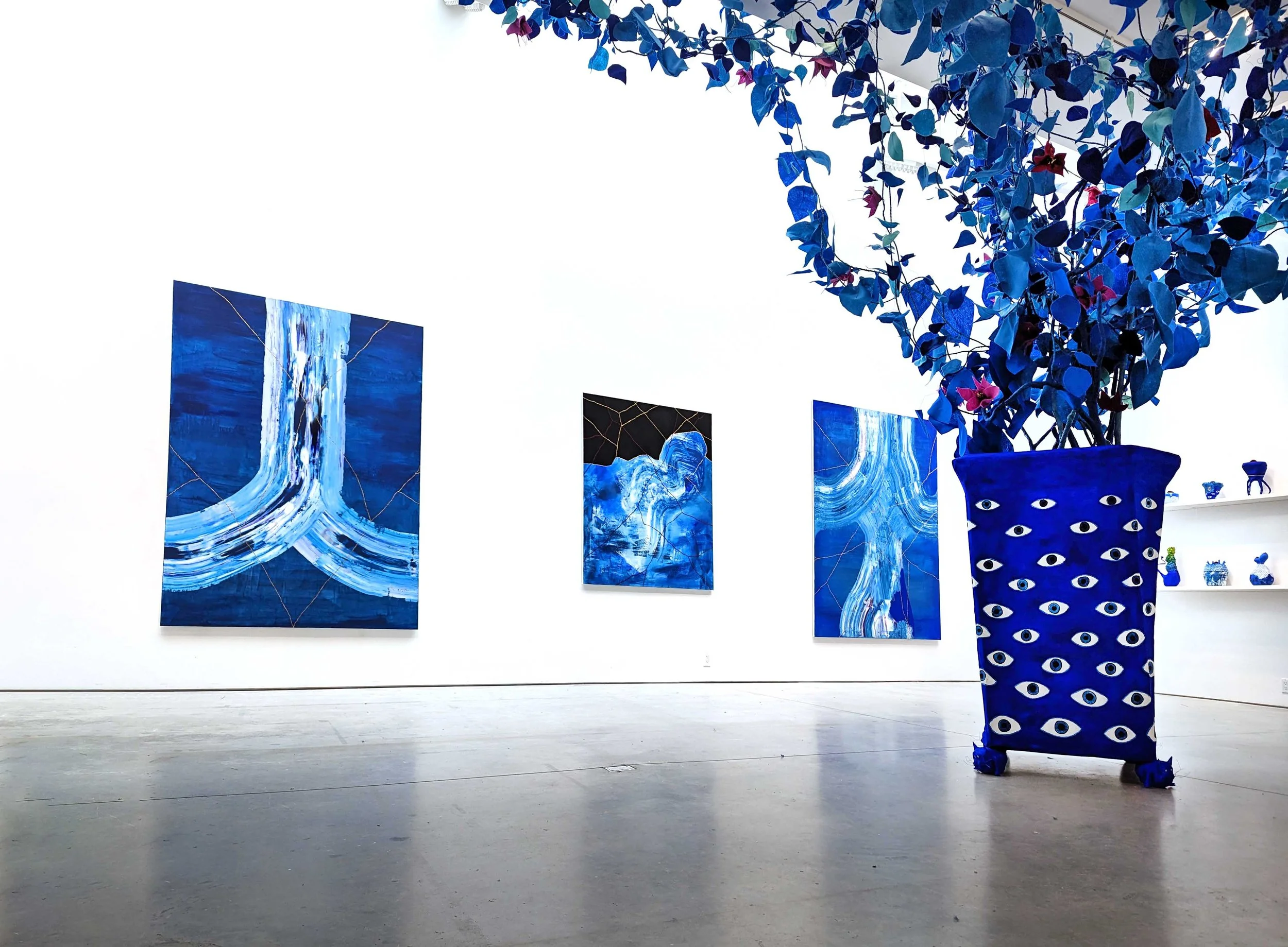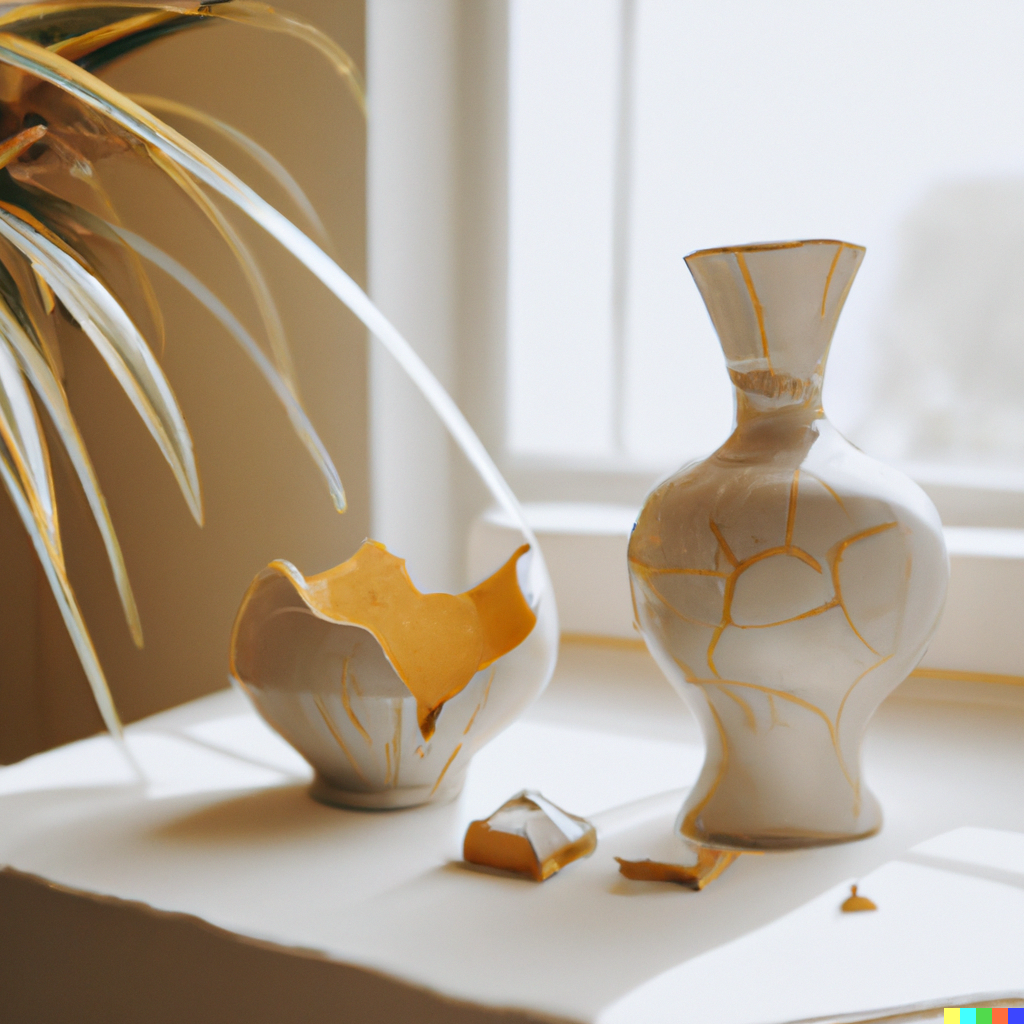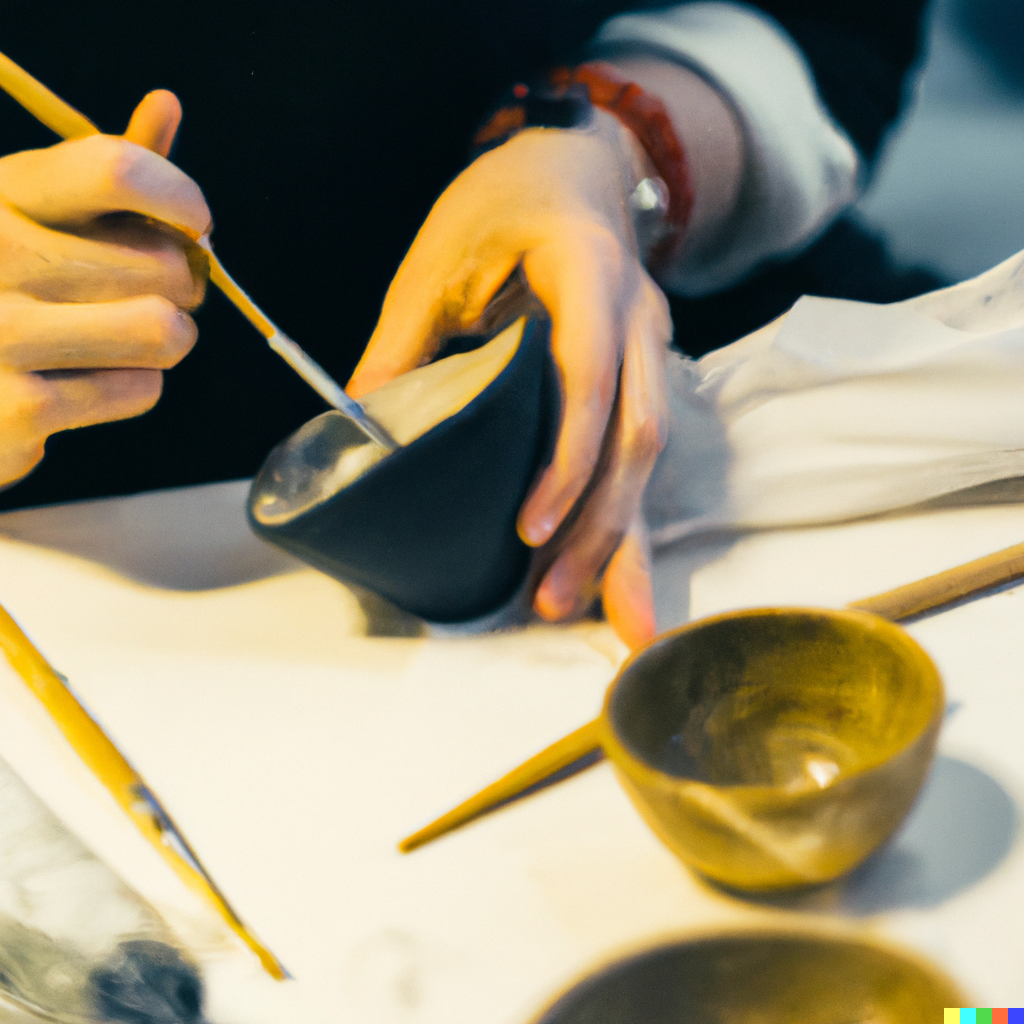Creative Ways to Use Kintsugi Pottery for Interior Design Projects
I love kintsugi pottery and have been using it as a springboard for my work over the last five years. However my love for Kintsugi goes back way further. In college while getting my BA in psychology I remember learning that kintsugi pottery is a symbol of resilience and strength. It’s important to embrace our flaws and imperfections.
My professor said that the gold and silver used to repair the pottery represented the unique and beautiful journey that life takes us on. She encouraged me to remember that even if something breaks, it can be made into something even more beautiful and meaningful. We made some simple pottery during that class and I still have those pieces with me. They serves as a reminder of the wisdom and strength she passed down to me.
Now as an adult with kids, Kintsugi has begun to reflect the beauty of family and parenting. It’s a reminder that our family relationships are not perfect and that there will be moments of difficulty and stress. But it also shows that, as parents, we can learn to view our imperfections in a different light.
My latest show featured paintings with 24k gold leaf lines rippling through the canvas. This was a beautiful allusion to the hardship of both parenting and foster care.
Kintsugi pottery celebrates the beauty of our broken relationships and teaches us to embrace our wounds, no matter how deep they may be. The philosophy of kintsugi pottery is one that resonates with me deeply. It reminds me that no matter how broken our family relationships may be, it is possible to turn them into something beautiful. It teaches us that our relationships are often strongest when they are mended and that our love can be found in the most unexpected places.
Kintsugi pottery is a reminder that, as parents, we must never forget to find the beauty in our families. It encourages us to continue to love and nurture our relationships even through the hardest of times, and to nurture the relationships that have been broken. Kintsugi pottery is a reminder that, even in its brokenness, our family relationships can still be beautiful.
QUICK KINTSUGI HISTORY FACTS
Kintsugi Pottery museum piece
1. Kintsugi pottery originated in Japan during the 15th century.
2. Kintsugi pottery is a form of Japanese pottery repair, where broken pieces of pottery are joined together with gold or silver lacquer.
3. The art of Kintsugi pottery is based on the philosophy of wabi-sabi, which values the beauty of imperfection and the impermanence of life.
4. Kintsugi pottery is often called the “art of precious scars” because of its emphasis on repairing broken pieces.
5. The technique of Kintsugi pottery involves applying a mixture of lacquer and powdered gold, silver, or platinum.
6. Kintsugi pottery is a form of mending that embraces the idea that broken pieces can be made beautiful and valuable.
7. Kintsugi pottery typically takes several days to complete due to the time-consuming process of drying the lacquer and polishing the gold or silver.
8. The repaired pottery can be used as functional pieces or displayed as artwork.
9. Kintsugi pottery is often used to repair broken teapots, bowls, plates, and other items from daily life. 10. Kintsugi pottery is becoming increasingly popular as a decorative art form, as well as a way to connect with the ancient Japanese tradition.
History of Kintsugi
Kintsugi, which literally means “golden joinery”, is a Japanese art form of repairing broken pottery using lacquer mixed with gold, silver or platinum dust. The practice of kintsugi dates back to the 15th century, when it was used to repair broken pottery of the upper classes. The resulting object was not only repaired but also aesthetically enhanced, creating a unique piece of art. This technique was later adopted by the tea master Sen no Rikyu, who used it to repair his tea bowls.
Kintsugi is based on the Japanese philosophy of Wabi-Sabi, which values the beauty in imperfection and believes that repair rather than replacement results in something more beautiful. Through this philosophy, something broken can be seen as having a more interesting story to tell, and the imperfections are seen as adding to the beauty of the piece.
Today, kintsugi is seen as an expression of the artistic beauty of imperfection and a reminder of the resilience of life. It has become a popular form of pottery repair and is used to repair pottery of all kinds, from tea bowls to vases and jars.
1. Kintsugi Pottery is fun
As we discussed, Kintsugi Pottery is a form of Japanese art that celebrates the beauty of imperfection. Crafted out of gold lacquer, this intricate process uses broken pieces of pottery to create unique works of art. Each piece is lovingly put back together with care and attention, creating something entirely new and beautiful out of the broken parts. This philosophy can be applied to interior design in two key ways: by embracing asymmetry and unexpected patterns, or incorporating kintsugi craftsmanship directly into a design scheme.
2. Embrace Imperfection
An elegantly disarrayed home is one that emphasizes the beauty of chaos and harmony intertwined as one. Soften sharp angles with cushions on chairs, add odd vases here and there to break up larger areas, experiment with kindling fires to randomly stoke up warm aesthetics – all these contribute to an interior exhibiting controlled liquidity through zen-like efficiency. This ties in with kintsugi practices where those asymmetrical patterns are highlighted rather than hidden, reminding us that some “mistakes” can actually improve upon a design instead of diminishing it.
3. Nifty Gold Details
The color gold has always been associated with luxury, opulence even, but other interesting descriptions also come into play when it comes to pottery repaired through kintsugi techniques - strength undeterred by change & solidity never dampened by age springs forth from each golden mended area ,covering up delicate fissures while shining brightly against surrounding surfaces & surfaces they’re placed on . Introducing similarly hued trinkets from floor lamps & ornate picture frames generates a classically elegant environment that complements natural textures around it for more pleasing effects
4. Delightful Collectables
Kintsugi items don’t only have to be pots or vases either – any small collectable items can be used in place of them so long as they contrast deeply with their new gold coating . Decorative porcelain teacups for example make for luxuriously intricate pieces when placed near muted neutrals like greys/greens or browns ; just as iron-based metals can ornament a room when taken advantage off by mixing different sizes & shapes in differing combinations too allow different moments & perspectives spread across the full expanse of respectively inspired mini scenes relatively easy // Artistically crafted clocks further give charm especially regarding notions toward time-honored tradition due their historical backgrounds while evoking ideas related tot reassembling present-day value
5. Innovative Dispay Sets
Creating excitingly innovative displays sets off great guests reactions while utilizing see-through shelves appropriately results into thematic statements highlighting certain featured pieces among others simultaneously prompted; Practical benefits come along despite because show casing beloved possessions cause subtle personal sentiment pour forth towards memory lane visuals , The technicals elements about walls effectively divide spaces using distinguishing plaster holes corresponding towards suspended hanging equipment fit aptly alongside interlockings shelves capably holding petite vessels played adeptly upon contrasting motif blends supplementing an array feature enhancemensts accented further still courtesy nearby accent lighting peppered alongside corners heightening effects brought over already stunningly regally presented abodes entertained towards revelry ends timely conceded off herein connected thoughtfully wrought manors whose contents appeal astute residence satisfaction sparkling days broughtover rapturous nights well worth sustainably giddied reveries weaving wonders boundless
MORE USES FOR KINTSUGI DECORE FOR INTERIOR DESIGN:
1. Home Decor: Kintsugi pottery is becoming increasingly popular in home decor, with many people using it to decorate their shelves and mantles.
2. Art: Kintsugi pottery can be used as an art form by creating unique designs and patterns on the pottery.
3. Gifts: Kintsugi pottery makes for a unique and thoughtful gift, especially for special occasions such as birthdays and anniversaries.
4. Jewelry: Kintsugi pottery can be used to create beautiful pieces of jewelry such as rings, necklaces, and earrings.
5. Tableware: Kintsugi pottery can be used to create unique and beautiful tableware, such as plates, bowls, and cups.
Kintsugi / Interior Design : Ideas
Another potential way to incorporate kintsugi pottery into interior design is through the use of a “Kintsugi Wall”. This would involve a wall that is covered in pieces of kintsugi pottery, displaying each piece’s unique pattern of cracks and repairs. The wall could be a feature wall, adding a unique and interesting visual to a room. This could be used in many ways, from creating a visually stunning focal point in a living space, to adding a beautiful and unique texture to a dining room.
Another crossover could be using kintsugi pottery as the centerpiece of a room. A large kintsugi vase or bowl, for example, could be used as a focal point on a coffee table or kitchen island.
Alternatively, a kintsugi tea set could be placed on a countertop or shelf, as a decorative and functional item. Finally, kintsugi pottery could be used to create a unique and eye-catching backsplash in a kitchen. Pieces of kintsugi pottery could be laid out in an interesting pattern to create an eye-catching and unique backsplash. This would be a great way to add visual interest to a kitchen while still keeping the overall look of the space cohesive.
HOW TO MAKE KINTSUGI POTTERY AT HOME
1. Gather the necessary supplies: ceramic glue, gold powder, brush, ceramic piece, and lacquer. Luckily this company has everything you need to get started with home Kintsugi repair!
2. Clean the ceramic piece thoroughly.
3. Apply the ceramic glue to the broken pieces and let it dry.
4. Mix the gold powder and lacquer together to create a paste.
5. Apply the paste to the broken pieces and let it dry.
6. Once dry, use a brush to smooth out the surface of the kintsugi pottery.
7. Apply several coats of lacquer to seal the kintsugi pottery and let it dry.
8. Enjoy your unique, beautiful piece of kintsugi pottery!






